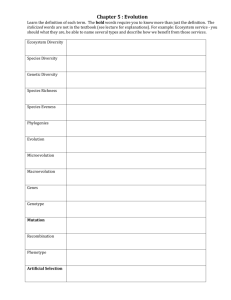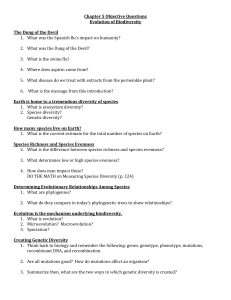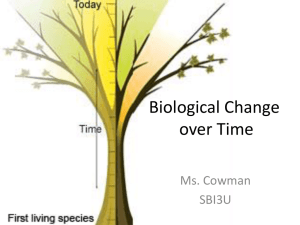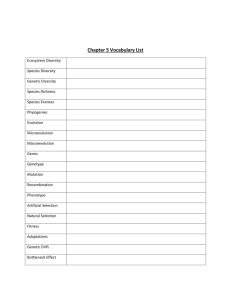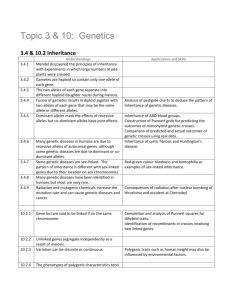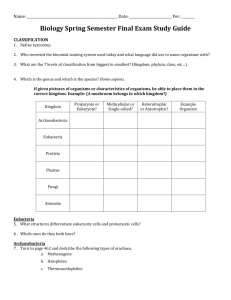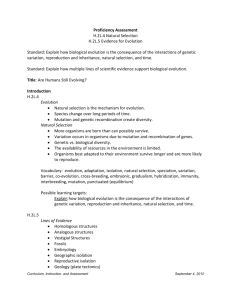File - Charlie Feht
advertisement
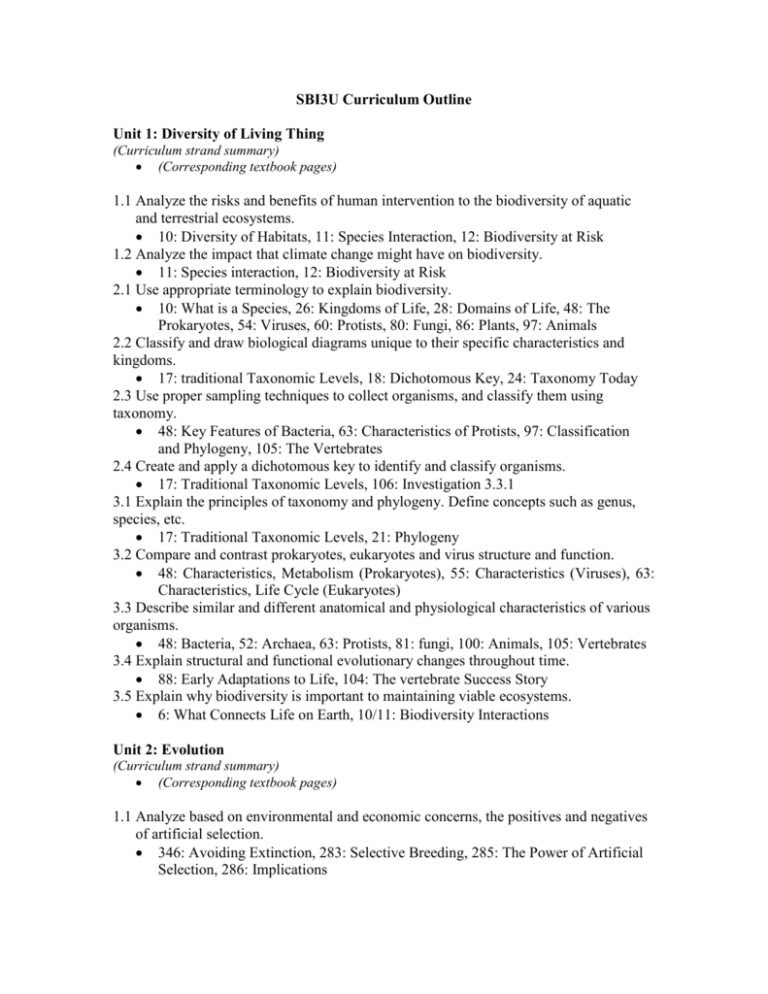
SBI3U Curriculum Outline Unit 1: Diversity of Living Thing (Curriculum strand summary) (Corresponding textbook pages) 1.1 Analyze the risks and benefits of human intervention to the biodiversity of aquatic and terrestrial ecosystems. 10: Diversity of Habitats, 11: Species Interaction, 12: Biodiversity at Risk 1.2 Analyze the impact that climate change might have on biodiversity. 11: Species interaction, 12: Biodiversity at Risk 2.1 Use appropriate terminology to explain biodiversity. 10: What is a Species, 26: Kingdoms of Life, 28: Domains of Life, 48: The Prokaryotes, 54: Viruses, 60: Protists, 80: Fungi, 86: Plants, 97: Animals 2.2 Classify and draw biological diagrams unique to their specific characteristics and kingdoms. 17: traditional Taxonomic Levels, 18: Dichotomous Key, 24: Taxonomy Today 2.3 Use proper sampling techniques to collect organisms, and classify them using taxonomy. 48: Key Features of Bacteria, 63: Characteristics of Protists, 97: Classification and Phylogeny, 105: The Vertebrates 2.4 Create and apply a dichotomous key to identify and classify organisms. 17: Traditional Taxonomic Levels, 106: Investigation 3.3.1 3.1 Explain the principles of taxonomy and phylogeny. Define concepts such as genus, species, etc. 17: Traditional Taxonomic Levels, 21: Phylogeny 3.2 Compare and contrast prokaryotes, eukaryotes and virus structure and function. 48: Characteristics, Metabolism (Prokaryotes), 55: Characteristics (Viruses), 63: Characteristics, Life Cycle (Eukaryotes) 3.3 Describe similar and different anatomical and physiological characteristics of various organisms. 48: Bacteria, 52: Archaea, 63: Protists, 81: fungi, 100: Animals, 105: Vertebrates 3.4 Explain structural and functional evolutionary changes throughout time. 88: Early Adaptations to Life, 104: The vertebrate Success Story 3.5 Explain why biodiversity is important to maintaining viable ecosystems. 6: What Connects Life on Earth, 10/11: Biodiversity Interactions Unit 2: Evolution (Curriculum strand summary) (Corresponding textbook pages) 1.1 Analyze based on environmental and economic concerns, the positives and negatives of artificial selection. 346: Avoiding Extinction, 283: Selective Breeding, 285: The Power of Artificial Selection, 286: Implications 1.2 Evaluate the impact of environmental changes on natural selection and species vulnerability. 304: The Theory of Evolution by Natural Selection, 334: Consequence of Human Influence 2.1 Use appropriate terminology to explain evolution. 282, 298, 326, 331, 336, 341 2.2 Use research to investigate key factors affecting evolution. 326: Natural Selection, 342: Divergent Evolution, 343: Convergent Evolution, 344: Coevolution, 346: Activity 8.4, 362: Cultural Evolution Influencing Biological Evolution 2.3 Analyze and report about various contributions of scientists to modern evolutionary theories. 288: Adaptation and Heredity, 291: Catastrophism and Uniformitarianism, 294: The HMS Beagle 2.4 Investigate natural and artificial selection, and analyze their different mechanisms. 326: Natural Selection, 329: Natural Selection in Action, 283: Selective Breeding, 285: The Power of Artificial Selection 3.1 Explain the theory of evolution using natural selection to illustrate it. 326-329: Types of Natural Selection 3.2 Explain individual adaptations of organisms to their environments. 306: Large Billed Finches on Galapagos Island, 329: Natural Selection in Action, 331: Scenario Challenge 3.3 Define speciation and explain how new species are formed. 336: Speciation 336: Mechanisms of Reproductive Isolation, 337: Allopatric Speciation, 339: Sympatric Speciation 3.4 Describe some evolutionary mechanisms and explain how they effect development and extinction over time. 331: Genetic Drift, 332: The Founder Effect, 349: Diversification and Mass Extinction, 363: Are Humans Still Evolving Unit 3: Genetic Processes (Curriculum strand summary) (Corresponding textbook pages) 1.1 Analyze the social and ethical implications of genetic research. 146: Cloning, 208: Exploring Genetic Screening, 242: DNA Identification, 245: Manipulating the Genome, 249: Setbacks, 250: Successes 1.2 Evaluate the importance of recent contributions to knowledge of genetics and genetic technologies. 202: The Gene Hunters, 245: Manipulating the Genome, 247: Products of Genetic Engineering 2.1 Use appropriate terminology to describe genetics. 184: Mendelian Inheritance, 187: Dominant and Recessive Alleles, 190: Test Crosses, 194: Variations in Heredity, 197: Pedigree, 210: dihybrid Cross 2.2 Investigate meiosis with the use of technology and draw diagrams of the phases of meiosis. 154-155: Meiosis I and II, 156: Random Assortment 2.3 Use punnet squares to solve problems such as monohybrid crosses, dihybrid crosses, dominance, sex linked crosses etc. 188: Predicting Inheritance of Alleles, 194: Incomplete Dominance and Codominance, 200: Sex Linkage, 211: Solving Dihybrids 2.4 Investigate test crosses. Use punnet squares and probability rules to analyze data. 188: Predicting Inheritance of Alleles, 201: Questions, 210: Independent Assortment, 211:Solving a Dihybrid Cross, 213: Probability, Product Law 3.1 Explain the phases of meiosis and the movement of chromosomes. 144-145, 153-156 3.2 Explain concepts of how DNA, genes, alleles, etc. contribute to heredity. 138: Genetic Material, 140: Sexual Reproduction, 152: Sexual Reproduction, 157: Gametogenesis, 228: DNA and the Code of Life 3.3 Explain terms like genotype, phenotype, dominant, recessive etc. according to Mendelian laws. 186: Mendel’s First Law of Genetics, 187: Dominant and Recessive Alleles, 194: Incomplete Dominance and Codominance 3.4 Describe some genetic disorders, including the physical effects and treatment options. 162: Nondisjunction, 204: Genetic Disorders, 206: Other Disorders, 235: Chromosomal Mutations 3.5 Describe reproductive technology and explain how it can increase genetic diversity. 207: Ontario Newborn Screening Program Unit 4: Animal Structure and Function (Curriculum strand summary) (Corresponding textbook pages) 1.1 Evaluate the importance of technological contribution, including Canadian contributions, to our understanding of internal body systems. 419: Endoscopy, 442: Spirometer, 459: New Technologies, 460: Artificial Lungs, 504: Looking Through the Body 1.2 Assess how societal need have lead to scientific and technological developments. 424: John Snow Excerpt, 485: Artificial Blood, 499: Observing the Heart Beat 2.1 Use appropriate terminology related to animal anatomy. 397, 400-402, 409, 413, 418, 441, 443, 480, 487, 499, 501 2.2 Perform a lab or a computer based simulation to dissect an animal and analyze the relationships between the circulatory, respiratory and digestive systems. 510: Activity 11.11.1 2.3 use medical equipment to monitor functional responses to the respiratory and circulatory system due to external stimuli. 465: Activity 10.2.1 3.1 Explain the anatomy of the respiratory system and the process of gas exchange. 438: Gas Exchange, Cellular Respiration, 442: Mechanisms, 447: Transport and Diffusion of Gas, 450: Maintaining Oxygen and Carbon Dioxide Levels 3.2 Explain the anatomy of the digestive system and the importance of providing nutrients needed for energy and growth to our body. 409: Structure of the Stomach, 410: Chemical Digestion, 412: Structure of the Small Intestine, 418: Structure of the Large Intestine 3.3 Explain the anatomy of the circulatory system and its function of transporting substances that are vital to our health. 482: What is Blood, 487-492: Blood Vessels, 489: Controlling Blood Flow in the Capillaries, 497: The Cardiac Cycle, 3.4 Describe disorders related to these three systems. 421: Nausea and Vomiting, 452: COPD, 454:Tuberculosis, Pneumonia, Cystic Fibrosis, 457: Smoking, 502: Treatment for Coronary Artery Disease Unit 5: Plant Anatomy, Growth and Function (Curriculum strand summary) (Corresponding textbook pages) 1.1 Evaluate the importance of plants to the growth and development of Canadian society. 540: Why are Plants so Useful, 571: Biomimicry, 573: Improving City Life With Trees 1.2 Evaluate ways other societies have used plants to help sustain human populations while supporting the environment as well. 550: Human Uses for Leaves, 556: Human Uses for Stems, 561: Human Uses for Roots, 562: Erosion Control 2.1 Use appropriate terminology related to plant anatomy, growth and function. 544, 548, 598, 605 2.2 Conduct research through inquiry to determine the factors affecting plant growth. 542: Basic Needs of Plants, 608, 609 2.3 Draw diagrams of specialized plant tissues using microscopes or through modeling. 575: Investigation 12.2.1, 576: Investigation 12.3.1 2.4 Investigate various methods of plant propagation. 592: Structures Involved, 593-594: Human Uses of Plant Asexual Reproduction 3.1 Describe structures in vascular plants and explain their transport methods. 543: The Vascular Plant body, 547: The Structure of Leaves, 554: Cell Types in Vascular Tissue, 559: General Structure of Roots, 564-570: Transport 3.2 Compare and contrast monocot and dicot plant structure and environments. 544: Updating Phylogeny of Vascular Plants, 577:Investigation 12.4.1 3.3 Explain the reproductive mechanisms of plants in natural reproduction and artificial propagation. 592: Asexual Reproduction, 594: Human Uses, 595: Sexual Reproduction, 599: Pollination and Fertilization 3.4 Describe factors effecting plant growth. 608: Environmental Factors Affecting Plant Growth, 609: Table 1, 613-617: Plant Growth Regulators 3.5 Explain ecological succession including plant roles in maintaining biodiversity and organism survival. 588: Succession, 590: Secondary Succession, Human Activity and Succession
